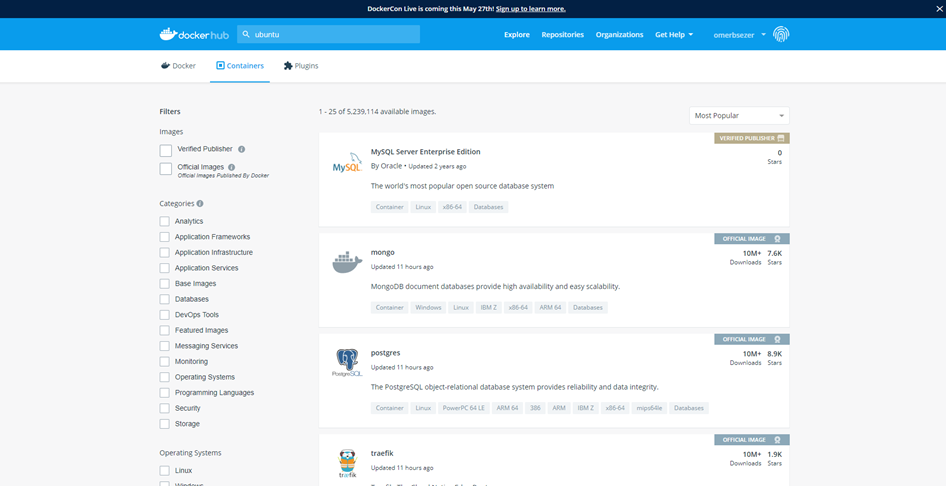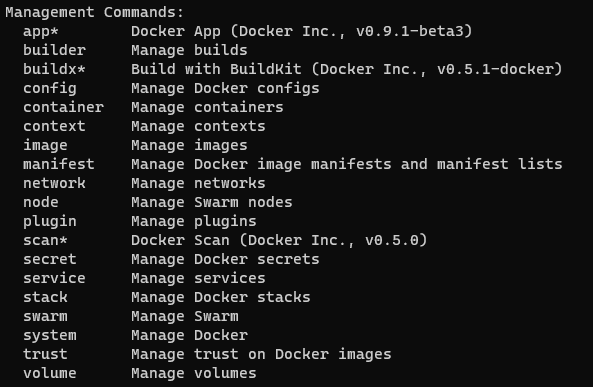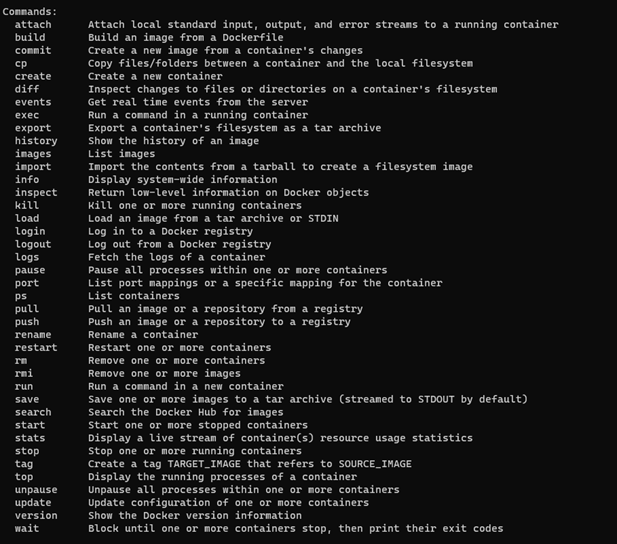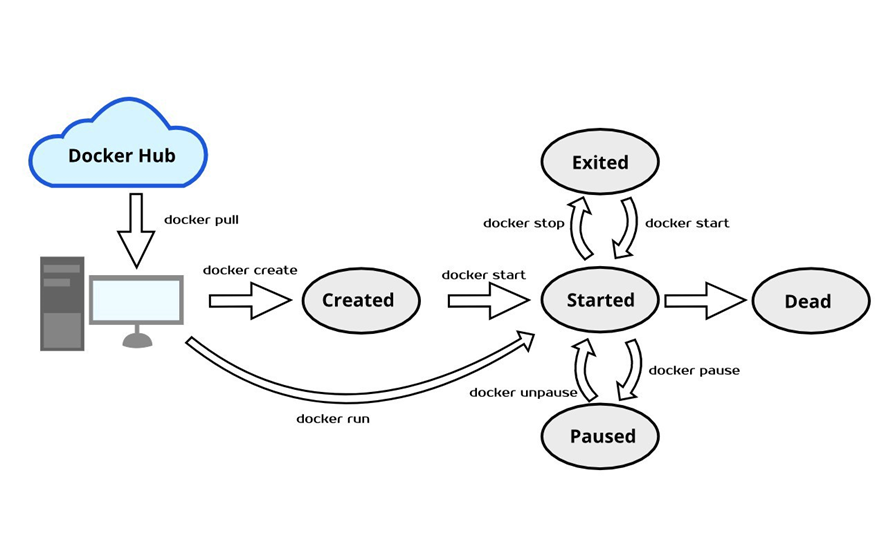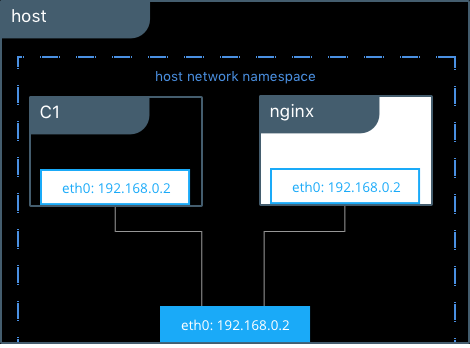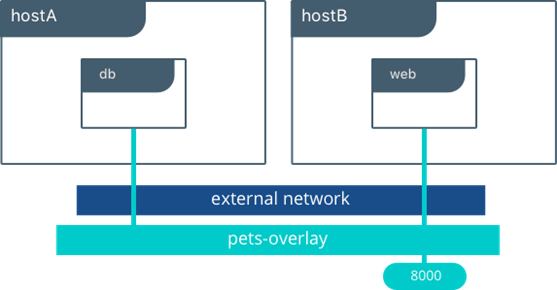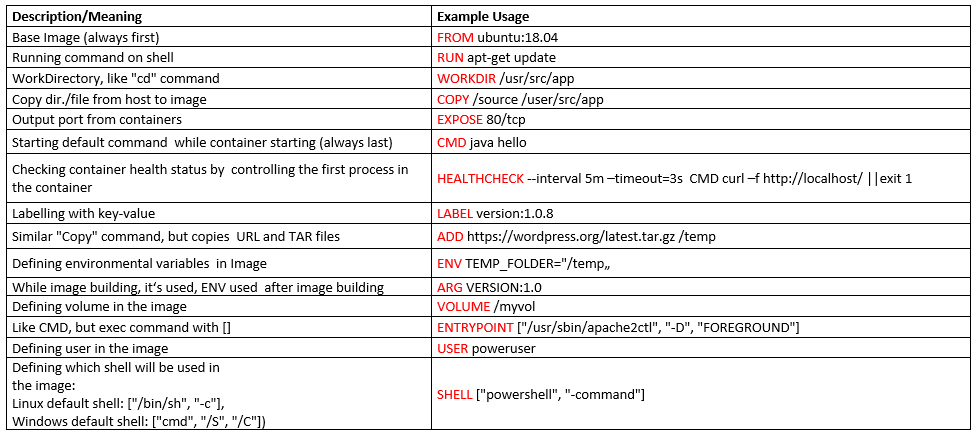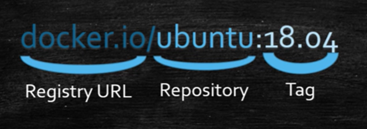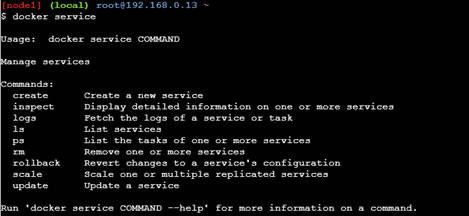This repo aims to cover Docker details (Dockerfile, Image, Container, Commands, Volumes, Docker-Compose, Networks, Security, Multi-Platform Builds) quickly, and possible example usage scenarios (HowTo: LABs) in a nutshell. This guide is updated with the latest Docker features and best practices for 2024/2025.
Keywords: Docker-Image, Dockerfile, Containerization, Docker-Compose, Docker-Volume, Docker-Network, Docker-Security, BuildKit, Multi-Platform, Distroless, Container-Security, Healthchecks, Cheatsheet.
Note: This guide has been updated for Docker 2024/2025 including Docker Compose v2, BuildKit, Multi-Platform Builds, and modern security practices.
- LAB-01: Creating First Docker Image and Container using Docker File
- LAB-02: Binding Volume to the Different Containers
- LAB-03: Docker-Compose v2 - Creating 2 Different Containers: WordPress Container depends on MySql Container
- LAB-06: Transferring Content between Host PC and Docker Container
- LAB-10: Multi-Platform Builds with Docker BuildKit
- LAB-11: Docker Security Best Practices - Distroless Images, Non-Root User, Vulnerability Scanning
- LAB-12: Healthchecks and .dockerignore Best Practices
- LAB-05: Running Docker Free Local Registry, Tagging Image, Pushing Image to the Local Registry, Pulling Image From Local Registry and Deleting Images from Local Registry
- LAB-09: Docker Configuration (Proxy, Registry)
- LAB-07: Creating Docker Container using Dockerfile to Build C++ on Ubuntu18.04
- LAB-08: Creating Docker Container using Dockerfile to Build C++ on Windows
- Motivation
- What is Docker?
- Architecture
- Installation
- Docker Engine (Daemon, REST API, CLI)
- Docker Registry and Docker Hub
- Docker Command Structure
- Docker Container
- Docker Volumes/Bind Mounts
- Docker Network
- Docker Log
- Docker Stats/Memory-CPU Limitations
- Docker Environment Variables
- Docker File
- Docker Image
- Docker Compose v2 (Updated 2024)
- Docker BuildKit (NEW 2024)
- Multi-Platform Builds (NEW 2024)
- Docker Security Best Practices (NEW 2024)
- Healthchecks (NEW 2024)
- .dockerignore Best Practices (NEW 2024)
- Docker Swarm (Legacy)
- Docker Stack / Docker Service (Legacy)
- Play With Docker
- Docker Commands Cheatsheet
- Container Orchestration: Kubernetes vs Swarm
- Other Useful Resources Related Docker
- References
Why should we use Docker? "Docker changed the way applications used to build and ship. It has completely revolutionized the containerization world." (Ref:ItNext)
- Installing all dependencies, setting up a new environment for SW (time-consuming every time to install environment for testing )
- We want to run our apps on different platforms (Ubuntu, Windows, Raspberry Pi).
- Question in our mind: What if, it does not run on a different OS?
- CI/CD Integration Testing: We can handle unit testing, component testing with Jenkins. What if integration testing?
- Extending Chain: Jenkins- Docker Image - Docker Container - Automatic testing
- Are our SW products portable to carry on different PC easily? (especially in the development & testing phase)
- Developing, testing, maintenance of code as one Monolithic App could be problematic when the app needs more features/services. It is required to convert one big monolithic app into microservices.
- NOT needed to install dependencies/SWs again & again
- Enables to run on different OS, different platforms
- Enables a consistent environment
- Enables more efficient use of system resources
- Easy to use and maintain
- Efficient use of the system resources
- Isolate SW components
- Enables faster software delivery cycles
- Containers give us instant application portability.
- Enables developers to easily pack, ship, and run any application as a lightweight, portable, self-sufficient container
- Microservice Architecture (Monolithic Apps to MicroService Architecture, e.g. Cloud Native App)
(Ref: Infoworld)
- Docker does NOT fix your security issues
- Docker does NOT turn applications magically into microservices
- Docker isn’t a substitute for virtual machines
(Ref: Infoworld)
- Docker is a tool that reduces the gap between the Development/Deployment phase of a software development cycle.
- Docker is like a VM but it has more features than VMs (no kernel, only small app and file systems, portable)
- On Linux Kernel (2000s) two features are added (these features support Docker):
- Namespaces: Isolate process.
- Control Groups: Resource usage (CPU, Memory) isolation and limitation for each process.
- On Linux Kernel (2000s) two features are added (these features support Docker):
- Without Docker, each VM consumes 30% of resources (Memory, CPU)
- Linux: Docker Engine
- Windows: Docker Desktop for Windows
- WSL: Windows Subsystem for Linux,
- WSL2: virtualization through a highly optimized subset of Hyper-V to run the kernel and distributions, better than WLS.
- Mac-OS: Docker Desktop for Mac
- There are mainly 3 components in the Docker Engine:
- Server is the docker daemon named docker daemon. Creates and manages docker images, containers, networks, etc.
- Rest API instructs docker daemon what to do.
- Command Line Interface (CLI) is the client used to enter docker commands.
- docker [ManagementCommand] [Command]
docker container ls -a
docker image ls
docker volume ls
docker network ls
docker container rm -f [containerName or containerID]
 (Ref: docker-handbook-borosan)
(Ref: docker-handbook-borosan)
- When we create the container from the image, in every container, there is an application that is set to run by default app.
- When this app runs, the container runs.
- When this default app finishes/stops, the container stops.
- There could be more than one app in docker image (such as: sh, ls, basic commands)
- When the Docker container is started, it is allowed that a single application is configured to run automatically.
docker container run --name mywebserver -d -p 80:80 -v test:/usr/share/nginx/html nginx
docker container ls -a
docker image pull alpine
docker image push alpine
docker image build -t hello . (run this command where “Dockerfile” is)
(PS: image file name MUST be “Dockerfile”, no extension)
docker save -o hello.tar test/hello
docker load -i <path to docker image tar file>
docker load -i .\hello.tar
Goto: App: Creating First Docker Image and Container using Docker File
e.g. [imageName]=alpine, busybox, nginx, ubuntu, etc.
docker image pull [imageName]
docker container run [imageName]
docker container start [containerId or containerName]
docker container stop [containerId or containerName]
docker container pause [containerId or containerName]
docker container unpause [containerId or containerName]
- Images are read only (R/O).
- When containers are created, new read-write (R/W) thin layer is created.
- Containers do not save the changes/logs when erased if there is not any binding to volume/mount.
- For persistence, volumes/mounts MUST be used.
- e.g. Creating a log file in the container. When the container is deleted, the log file also deleted with the container. So volumes/binding mounts MUST be used to provide persistence!
 (Ref: udemy-course:adan-zye-docker)
(Ref: udemy-course:adan-zye-docker)
- Volumes and binding mounts must be used for saving logs, output files, and input files.
- When volumes bind to the directory in the container, this directory and volume are synchronized.
docker volume create [volumeName]
docker volume create test
docker container run --name [containerName] -v [volumeName]:[pathInContainer] [imageName]
docker container run --name c1 -v test:/app alpine
Goto: App: Binding Volume to the Different Containers
docker container run --name [containerName] -v [pathInHost]:[pathInContainer] [imageName]
docker container run --name c1 -v C:\test:/app alpine
Goto: App: Binding Mount to Container Goto: App: Transferring Content between Host PC and Docker Container
- Docker containers work like VMs.
- Every Docker container has network connections
- Docker Network Drivers:
- None
- Bridge
- Host
- Macvlan
- Overlay
- Default Network Driver: Bridge (--net bridge)
docker network create [networkName]
docker network create bridge1
docker container run --name [containerName] --net [networkName] [imageName]
docker container run --name c1 --net bridge1 alpine sh
docker network inspect bridge1
docker container run --name c2 --net bridge1 alpine sh
docker network connect bridge1 c2
docker network inspect bridge1
docker network disconnect bridge1 c2
- Creating a new network using customized network parameters:
docker network create --driver=bridge --subnet=10.10.0.0/16 --ip-range=10.10.10.0/24 --gateway=10.10.10.10 newbridge
- Containers reach host network interfaces (--net host)
docker container run --name [containerName] --net [networkName] [imageName]
docker container run --name c1 --net host alpine sh
- Each Container has its own MAC interface (--net macvlan)
- Containers that work on different PCs/hosts can work as the same network (--net overlay)
- Mapping Host PC's port to container port:
-p [hostPort]:[containerPort], --publish [hostPort]:[containerPort] e.g. -p 8080:80, -p 80:80
docker container run --name mywebserver -d -p 80:80 nginx
- Docker Logs show /dev/stdout, /dev/stderror
docker logs --details [containerName]
Goto: App: Creating Docker Container using Dockerfile to Build C++ on Ubuntu18.04
Goto: App: Creating Docker Container using Dockerfile to Build C++ on Windows
FROM python:alpine3.7
COPY . /app
WORKDIR /app
RUN pip install -r requirements.txt
EXPOSE 5000
CMD python ./index.py
FROM ubuntu:18.04
RUN apt-get update -y
RUN apt-get install default-jre -y
WORKDIR /myapp
COPY /myapp .
CMD ["java","hello"]
- Multistage Docker File (Creating temporary container):
- In the example, JDK (Java Development Kit) based temporary image (~440MB) container is created for compilation.
- Compiled files are copied into JRE (Java Runtime Environment) based image (~145MB). Finally, we have only JRE based image.
COPY --from=<stage 1> stage1/src stage2/destination
- In the example below, 'compiler' is 'stage1'.
FROM mcr.microsoft.com/java/jdk:8-zulu-alpine AS compiler
COPY /myapp /usr/src/myapp
WORKDIR /usr/src/myapp
RUN javac hello.java
FROM mcr.microsoft.com/java/jre:8-zulu-alpine
WORKDIR /myapp
COPY --from=compiler /usr/src/myapp .
CMD ["java", "hello"]
- Create Image using Dockerfile
docker image build -t hello . (run this command where “Dockerfile” is)
(PS: image file name MUST be “Dockerfile”, no extension)
docker image pull [imageName]
docker image push [imageName]
docker image tag [imageOldName] [imageNewName]
(PS: If you want to push DockerHub, [imageNewName]=[username]/[imageName]:[version])
docker save -o hello.tar test/hello
docker load -i <path to docker image tar file>
docker load -i .\hello.tar
Goto: App: Creating First Docker Image and Container using Docker File
IMPORTANT UPDATE 2024: Docker Compose v1 (docker-compose) was deprecated in June 2023. Use Docker Compose v2 (docker compose with a space) instead!
- Define and run multi-container applications with Docker.
- Easy to create Docker components using one file: Docker Compose file
- It is a YAML file that defines components:
- Services,
- Volumes,
- Networks,
- Secrets
- Command syntax:
docker compose(with space) instead ofdocker-compose(with hyphen) - Container naming: Uses hyphen (-) as separator instead of underscore (_)
- Version field: The
version:field is now obsolete - start directly withservices: - Better integration: Integrated into Docker CLI platform
- Improved performance: Better build performance with BuildKit
# Note: version field is obsolete in Compose v2
services:
mydatabase:
image: mysql:8.0
restart: always
volumes:
- mydata:/var/lib/mysql
environment:
MYSQL_ROOT_PASSWORD: somewordpress
MYSQL_DATABASE: wordpress
MYSQL_USER: wordpress
MYSQL_PASSWORD: wordpress
networks:
- mynet
healthcheck:
test: ["CMD", "mysqladmin", "ping", "-h", "localhost"]
timeout: 20s
retries: 10
mywordpress:
image: wordpress:latest
depends_on:
mydatabase:
condition: service_healthy
restart: always
ports:
- "80:80"
- "443:443"
environment:
WORDPRESS_DB_HOST: mydatabase:3306
WORDPRESS_DB_USER: wordpress
WORDPRESS_DB_PASSWORD: wordpress
WORDPRESS_DB_NAME: wordpress
networks:
- mynet
healthcheck:
test: ["CMD", "curl", "-f", "http://localhost"]
interval: 30s
timeout: 10s
retries: 3
volumes:
mydata: {}
networks:
mynet:
driver: bridge# Start services
docker compose up -d
# Stop services
docker compose down
# View logs
docker compose logs -f
# List running containers
docker compose ps
# Build or rebuild services
docker compose build
# Pull service images
docker compose pullMigration Note: For most projects, switching to Compose v2 requires no changes to your YAML file. Simply use
docker composeinstead ofdocker-compose.
BuildKit is enabled by default since Docker 23.0 - It's the modern build engine for Docker!
BuildKit is Docker's next-generation build system that provides improved performance, better caching, and new features for building container images.
- Parallel build stages: Build independent stages concurrently
- Improved caching: More efficient layer caching and cache reuse
- Build secrets: Securely pass secrets without including them in the image
- SSH forwarding: Access private repositories during build
- Advanced Dockerfile syntax: New instructions and capabilities
# Enable for single build
DOCKER_BUILDKIT=1 docker build .
# Enable permanently (Linux/Mac)
export DOCKER_BUILDKIT=1
# Enable permanently (Windows PowerShell)
$env:DOCKER_BUILDKIT=1# syntax=docker/dockerfile:1.4
FROM ubuntu:22.04
# Using build secrets (won't be stored in image)
RUN --mount=type=secret,id=mysecret \
cat /run/secrets/mysecret
# Using SSH forwarding for private repos
RUN --mount=type=ssh \
git clone [email protected]:private/repo.git
# Cache mount for package managers
RUN --mount=type=cache,target=/var/cache/apt \
apt-get update && apt-get install -y python3docker build --secret id=mysecret,src=./secret.txt .Multi-platform builds allow you to create Docker images that work on different architectures (AMD64, ARM64, etc.) with a single build command.
- Support ARM-based systems (Apple Silicon M1/M2/M3, Raspberry Pi, AWS Graviton)
- Support AMD64 (Intel/AMD) systems
- Create truly portable container images
- One image works everywhere
# Create a new builder instance
docker buildx create --name mybuilder --use
# Bootstrap the builder
docker buildx inspect --bootstrap
# List available builders
docker buildx ls# Build for AMD64 and ARM64
docker buildx build --platform linux/amd64,linux/arm64 -t myapp:latest .
# Build and push to registry
docker buildx build --platform linux/amd64,linux/arm64 \
-t username/myapp:latest --push .
# Build for specific platform only
docker buildx build --platform linux/arm64 -t myapp:arm64 .# syntax=docker/dockerfile:1.4
FROM --platform=$BUILDPLATFORM golang:1.21 AS builder
ARG TARGETPLATFORM
ARG BUILDPLATFORM
ARG TARGETOS
ARG TARGETARCH
WORKDIR /app
COPY . .
# Cross-compile for target platform
RUN CGO_ENABLED=0 GOOS=${TARGETOS} GOARCH=${TARGETARCH} \
go build -o myapp .
FROM alpine:latest
COPY --from=builder /app/myapp /usr/local/bin/
CMD ["myapp"]$BUILDPLATFORM- Platform where build is running$TARGETPLATFORM- Platform for which you are building$TARGETOS- OS component of TARGETPLATFORM$TARGETARCH- Architecture component of TARGETPLATFORM
Goto: LAB-10: Multi-Platform Builds with Docker BuildKit
CRITICAL: According to 2024 Docker Security Report, vulnerabilities in container images increased by 25% year-over-year. Security is not optional!
Distroless images contain only your application and runtime dependencies - no shell, no package managers, no unnecessary tools.
Benefits:
- Smaller attack surface: 90%+ reduction in potential vulnerabilities
- Smaller image size: Often 10-50MB instead of 100-500MB
- Better security: No shell means attackers can't execute commands even if they breach the container
Popular Distroless Base Images:
# Static binary (1.9 MB)
FROM gcr.io/distroless/static-debian12
# For apps needing glibc (29.7 MB)
FROM gcr.io/distroless/base-debian12
# For C/C++ apps (32.3 MB)
FROM gcr.io/distroless/cc-debian12
# For Python apps
FROM gcr.io/distroless/python3-debian12
# For Java apps
FROM gcr.io/distroless/java17-debian12
# For Node.js apps
FROM gcr.io/distroless/nodejs20-debian12Example with Multi-Stage Build:
# Build stage
FROM node:20 AS builder
WORKDIR /app
COPY package*.json ./
RUN npm ci --only=production
COPY . .
# Production stage - Distroless
FROM gcr.io/distroless/nodejs20-debian12
COPY --from=builder /app /app
WORKDIR /app
CMD ["index.js"]WARNING: 58% of container images run as root (UID 0). This is a major security risk!
Why it matters:
- If attacker breaks out of container, they have root on host
- Principle of least privilege
- Industry best practice and compliance requirement
Implementation:
FROM ubuntu:22.04
# Create non-root user
RUN groupadd -r appuser && useradd -r -g appuser appuser
# Install dependencies as root
RUN apt-get update && apt-get install -y python3
# Change ownership
COPY --chown=appuser:appuser . /app
# Switch to non-root user
USER appuser
WORKDIR /app
CMD ["python3", "app.py"]For Distroless (use numeric UID):
FROM gcr.io/distroless/python3-debian12
COPY --chown=65532:65532 /app /app
USER 65532
CMD ["app.py"]Scan your images regularly for known vulnerabilities (CVEs).
Tools:
# Docker Scout (built into Docker Desktop)
docker scout quickview myapp:latest
docker scout cves myapp:latest
docker scout recommendations myapp:latest
# Trivy (open source, very popular)
trivy image myapp:latest
# Grype (from Anchore)
grype myapp:latest
# Snyk
snyk container test myapp:latestEnable Docker Scout in CI/CD:
# GitHub Actions example
- name: Docker Scout Scan
uses: docker/scout-action@v1
with:
command: cves
image: myapp:latest# syntax=docker/dockerfile:1.4
FROM ubuntu:22.04
# Update packages to latest security patches
RUN apt-get update && apt-get upgrade -y
# Don't include secrets in image
# BAD: COPY .env /app/
# GOOD: Use docker build --secret or environment variables at runtime
# Use specific versions, not 'latest'
FROM node:20.11.0-alpine3.19 # Good
# FROM node:latest # Bad
# Minimize installed packages
RUN apt-get install -y --no-install-recommends \
python3 \
&& rm -rf /var/lib/apt/lists/*
# Set read-only root filesystem
# docker run --read-only myapp
# Drop capabilities
# docker run --cap-drop=ALL --cap-add=NET_BIND_SERVICE myappGoto: LAB-11: Docker Security Best Practices
Important: Without healthchecks, Docker cannot detect if your containerized service is unhealthy, preventing automatic restarts or recovery.
Healthchecks tell Docker how to test if your container is working correctly. A container might be "running" but the application inside might be unresponsive.
FROM nginx:alpine
# HTTP healthcheck
HEALTHCHECK --interval=30s --timeout=3s --start-period=5s --retries=3 \
CMD wget --quiet --tries=1 --spider http://localhost/ || exit 1
# Alternative with curl
HEALTHCHECK --interval=30s --timeout=3s \
CMD curl -f http://localhost/ || exit 1
# For database
HEALTHCHECK --interval=10s --timeout=3s \
CMD mysqladmin ping -h localhost || exit 1
# For custom app
HEALTHCHECK CMD /app/healthcheck.sh || exit 1--interval=30s- Run check every 30 seconds--timeout=3s- Command must complete within 3 seconds--start-period=5s- Give container 5 seconds to start before checking--retries=3- Need 3 consecutive failures to mark unhealthy
services:
web:
image: myapp
healthcheck:
test: ["CMD", "curl", "-f", "http://localhost:8080/health"]
interval: 30s
timeout: 10s
retries: 3
start_period: 40s
db:
image: postgres:16
healthcheck:
test: ["CMD-SHELL", "pg_isready -U postgres"]
interval: 10s
timeout: 5s
retries: 5# View health status
docker ps
# Inspect health details
docker inspect --format='{{json .State.Health}}' container_name | jq
# Depends on healthy service (Compose v2)
services:
web:
depends_on:
db:
condition: service_healthyThe .dockerignore file tells Docker which files to exclude from the build context, improving build speed and security.
- Faster builds: Don't copy unnecessary files
- Smaller context: Less data sent to Docker daemon
- Security: Don't accidentally include secrets
- Efficiency: Better layer caching
# .dockerignore
# Git
.git
.gitignore
.gitattributes
# CI/CD
.github
.gitlab-ci.yml
.travis.yml
Jenkinsfile
# Docker
docker-compose*.yml
Dockerfile*
.dockerignore
# Documentation
README.md
CHANGELOG.md
LICENSE
docs/
*.md
# Dependencies (will be installed in container)
node_modules/
venv/
__pycache__/
*.pyc
vendor/
# Build outputs
dist/
build/
target/
out/
*.egg-info/
# IDE
.vscode/
.idea/
*.swp
*.swo
*~
.DS_Store
# Testing
coverage/
.coverage
*.test
test/
tests/
spec/
*.spec.ts
# Secrets (CRITICAL!)
.env
.env.*
*.pem
*.key
*.crt
secrets/
credentials.json
# Logs
*.log
logs/
# OS
Thumbs.db
.DS_Store
# Large files
*.tar
*.zip
*.gz
*.mp4
*.avi
# Keep specific files (! prefix)
!.env.example
# See what will be included in build context
docker build --no-cache --progress=plain -t test . 2>&1 | grep "Transferring context"
# Or use docker buildx
docker buildx build --progress=plain .Goto: LAB-12: Healthchecks and .dockerignore Best Practices
NOTE: Docker Swarm is now considered legacy. For production orchestration, consider Kubernetes instead. See Container Orchestration section.
One of the Container Orchestration tool:
- Automating and scheduling the
- deployment,
- management,
- scaling, and
- networking of containers
- Container Orchestration tools:
- Docker Swarm,
- Kubernetes,
- Mesos
 (Ref: udemy-course:adan-zye-docker)
(Ref: udemy-course:adan-zye-docker)
- With Docker Stack, multiple services can be created with one file.
- It is like a Docker-Compose file but it has more features than a Docker-compose file: update_config, replicas.
- But it is running on when Docker Swarm mode is activated.
- Network must be 'overlay'.
docker service create --name testservice --replicas=5 -p 8080:80 nginx
docker service ps testservice (listing running containers on which nodes)
docker service inspect testservice
docker service scale testservice=10 (scaling up the containers to 10 replicas)
docker service update --detach --update-delay 5s --update-parallelism 2 --image nginx:v2 testservice (previous state: testservice created, now updating)
docker service update --help (to see the parameters of update)
docker service rollback --detach testservice (rollbacking to previous state)
Goto: Docker Commands Cheatsheet
Industry Standard 2024: Kubernetes is the de facto standard for container orchestration in production environments.
Docker Swarm Status:
- Docker Swarm is now considered legacy technology
- Limited development and new features since 2020
- Smaller community and ecosystem
- Basic orchestration capabilities
- Good for: Simple deployments, learning, small projects
Kubernetes Advantages:
- Industry standard: Used by 88% of organizations (CNCF Survey 2024)
- Massive ecosystem: Helm charts, operators, monitoring tools, service meshes
- Cloud native: Native support in AWS (EKS), Azure (AKS), Google Cloud (GKE)
- Advanced features: Auto-scaling, rolling updates, self-healing, advanced networking
- Enterprise support: RedHat OpenShift, Rancher, VMware Tanzu
- Better for: Production workloads, microservices, multi-cloud, complex applications
Use Docker Compose (Single Host):
- Development environments
- Simple applications
- Testing
- Single server deployments
Use Kubernetes (Multi-Host Production):
- Production microservices
- Applications requiring high availability
- Multi-datacenter deployments
- Complex networking requirements
- Auto-scaling needs
Use Docker Swarm (Legacy/Learning):
- Learning container orchestration basics
- Legacy systems already using Swarm
- Very simple multi-host deployments
- Quick prototypes
# deployment.yaml
apiVersion: apps/v1
kind: Deployment
metadata:
name: myapp
spec:
replicas: 3
selector:
matchLabels:
app: myapp
template:
metadata:
labels:
app: myapp
spec:
containers:
- name: myapp
image: myapp:latest
ports:
- containerPort: 8080
resources:
requests:
memory: "64Mi"
cpu: "250m"
limits:
memory: "128Mi"
cpu: "500m"
livenessProbe:
httpGet:
path: /health
port: 8080
initialDelaySeconds: 30
periodSeconds: 10
---
apiVersion: v1
kind: Service
metadata:
name: myapp-service
spec:
type: LoadBalancer
selector:
app: myapp
ports:
- protocol: TCP
port: 80
targetPort: 8080- Start: Docker basics (images, containers, volumes, networks)
- Next: Docker Compose for multi-container apps
- Then: Kubernetes fundamentals (if targeting production)
- Advanced: Service meshes (Istio, Linkerd), GitOps (ArgoCD, Flux)
- Official Documentation: https://kubernetes.io/docs/
- Interactive Tutorial: https://kubernetes.io/docs/tutorials/kubernetes-basics/
- Minikube (Local Kubernetes): https://minikube.sigs.k8s.io/
- K3s (Lightweight Kubernetes): https://k3s.io/
- CNCF Landscape: https://landscape.cncf.io/
- Official Docker Documentation: https://docs.docker.com/
- Docker BuildKit Documentation: https://docs.docker.com/build/buildkit/
- Docker Compose v2 Documentation: https://docs.docker.com/compose/
- Multi-Platform Builds: https://docs.docker.com/build/building/multi-platform/
- Docker Security: https://docs.docker.com/engine/security/
- Docker Scout: https://docs.docker.com/scout/
- Trivy Security Scanner: https://github.com/aquasecurity/trivy
- Distroless Container Images: https://github.com/GoogleContainerTools/distroless
- Docker Security Best Practices: https://cheatsheetseries.owasp.org/cheatsheets/Docker_Security_Cheat_Sheet.html
- Snyk Container Security: https://snyk.io/product/container-vulnerability-management/
- Docker Tutorial for Beginners [FULL COURSE in 3 Hours]: https://www.youtube.com/watch?v=3c-iBn73dDE&t=6831s
- Docker and Kubernetes Tutorial | Full Course: https://www.youtube.com/watch?v=bhBSlnQcq2k&t=3088s
- Play with Docker (Interactive Labs): https://labs.play-with-docker.com/
- Docker Workshop: https://dockerlabs.collabnix.com/workshop/docker/
- Docker Cheatsheet: https://github.com/wsargent/docker-cheat-sheet
- Various Dockerfiles for Different Purposes: https://github.com/jessfraz/dockerfiles
- Dockerfile Best Practices: https://github.com/dnaprawa/dockerfile-best-practices
- All-in-one Docker Image for Deep Learning: https://github.com/floydhub/dl-docker
- Dive (Explore Docker Image Layers): https://github.com/wagoodman/dive
- Hadolint (Dockerfile Linter): https://github.com/hadolint/hadolint
- Docker Blog: https://www.docker.com/blog/
- Docker 2024 Highlights: https://www.docker.com/blog/docker-2024-highlights/
- 8 Top Docker Tips & Tricks for 2024: https://www.docker.com/blog/8-top-docker-tips-tricks-for-2024/
- Docker Security in 2025: https://cloudnativenow.com/topics/cloudnativedevelopment/docker/



